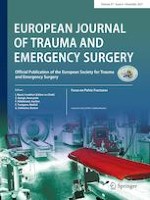Erschienen in:

23.03.2020 | Original Article
Trauma patients eligible for resuscitative endovascular balloon occlusion of the aorta (REBOA), a retrospective cohort study
verfasst von:
Victor Mill, Eric Wellme, Carl Montán
Erschienen in:
European Journal of Trauma and Emergency Surgery
|
Ausgabe 6/2021
Einloggen, um Zugang zu erhalten
Abstract
Purpose
Non-compressible torso hemorrhage is a major but potentially preventable cause of trauma-related mortality. REBOA has rapidly emerged as an adjunct for hemorrhage control. However, little is known about the proportion of trauma patients in which REBOA may be indicated. The aim of our study was to determine this proportion.
Methods
A retrospective cohort study of all adult (≥ 16 years) trauma patients treated at our facility (a university hospital and trauma referral center covering 2.5 million inhabitants) between 2012 and 2017 was performed. Potential candidates for REBOA were patients with an abdominal and/or pelvic injury and an Abbreviated Injury Scale (AIS) score of ≥ 3, who arrived in shock (defined as a systolic blood pressure, SBP ≤ 90 mmHg). Patients with potential contraindication for REBOA (prehospital cardiac arrest or thoracic vascular injury) were excluded.
Results
From a total of 7229 patients during the study years, 31 (0.4%) patients met the criteria for potential use of REBOA. In this cohort, the total mortality was 45% and the mortality within 30 days was 26%. The mean Injury Severity Score (ISS) was 46.3 and mean SBP was 72 mmHg.
Conclusions
The study suggests a potential indication for REBOA (incidence) of 2.5 per one million inhabitants per year according to the used criteria. Local REBOA guidelines may vary but a significant number of trauma centers use similar criteria. Although the total mortality within this group is high, the number of patients that theoretically may benefit from the use of REBOA is low.











